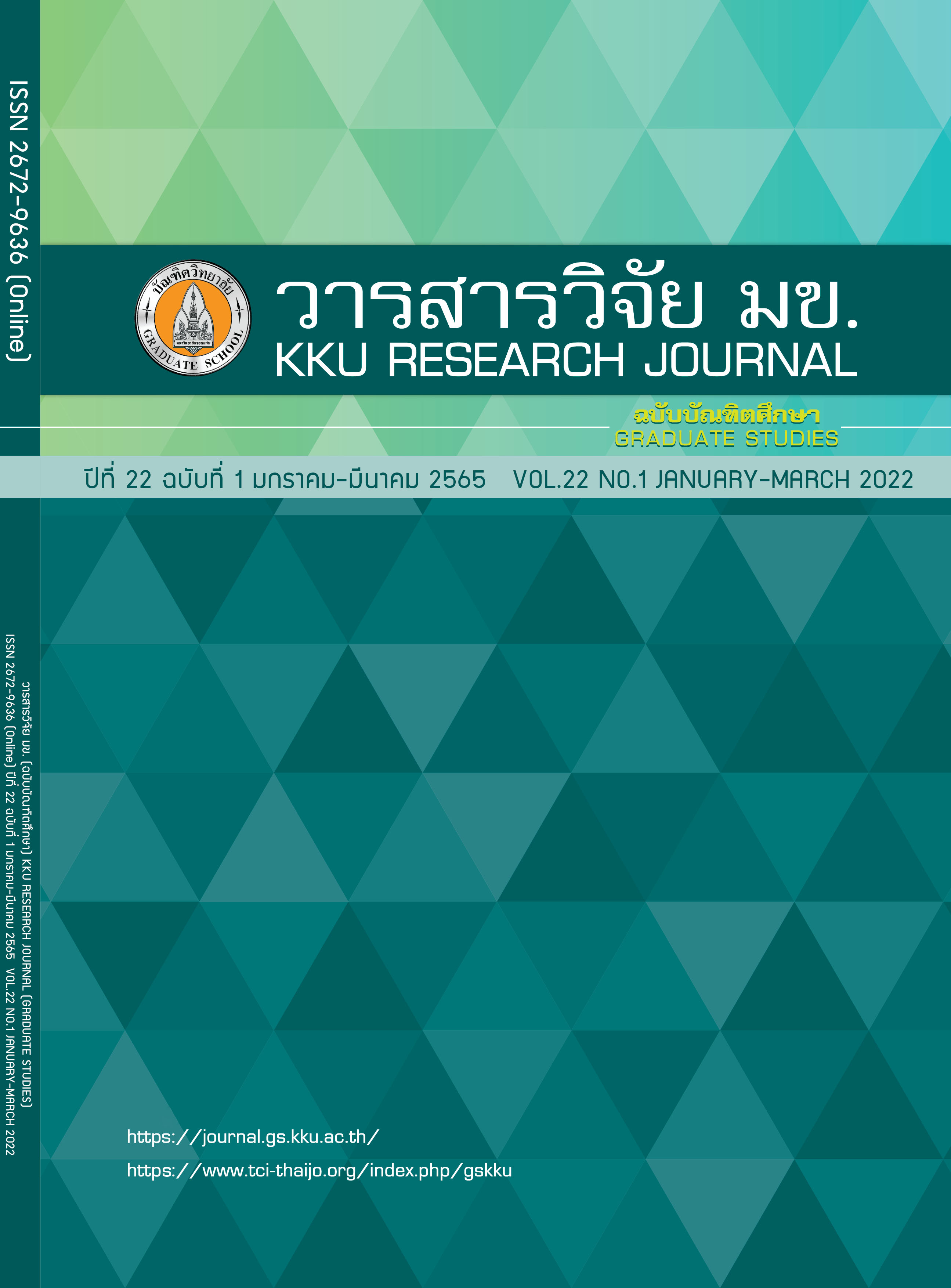Reducing the Environmental Impact of Rice Cultivation by Site-Specific Nutrients Management and using Chicken Manure in Combination with Chemical Fertilizers
Keywords:
Rice, Site - specific nutrients management, Chicken manureAbstract
The cultivation of rice caused the water and soil environmental impact due to using large amount of chemical fertilizers. This research aimeds to use site-specific nutrients management, soil physical and chemical properties for the rice cultivation in Ban Khoi Subdistrict, Muang District, Lopburi Province by Fertilizer Usage Calculator by Soil Analysis (FCS). The soil analysis results revealed that the value of Total Nitrogen and Available Phosphorus (P) were low and Available Potassium (K) was moderate. After that, calculating with application FCS revealed that the fertilizer formula was 6 - 5 - 3 (Urea (46 - 0 - 0), DAP (18 - 46 - 0) and MOP (0 - 0 - 60)) and the fertilizer ratio was 3, 11 and 5 kg/rai at the 1st fertilizer addition and the 2nd fertilizer addition was urea 7 kg/rai. Addition, the variable chicken manure was used as alternative chemical fertilizer in treatments. The results showed that 75% tailor-made fertilizer with 25% chicken manure gave the highest productivity at 520.30 kg/rai. This study shown that it was able to reduce fertilizer usage at 20.50 kg/rai when compared to the rice conventional irrigation and also reduce environmental impact.
References
Office of Agricultural Economics. Agricultural economics database [Internet]. 2019. Available from: http://www.oae.go.th/
Wannasai C. Management of primary nutrients in rice fields. Bangkok: Department of Agriculture; 2004. Thai.
Office of Agricultural Economics. Quantity and value of import chemical fertilizers [Internet]. 2020 [update 2020 Apr 1; cited 2020 Nov 20]. Available from: http://www.oae.go.th/view/1/
Kaweewong J. Nitrogen management for Hom - nin rice production grown on Mea Tha soil series. Khon Kaen Agr J. 2020; 48(1): 189 - 200. Thai.
Jaroenchasri R. Preliminary analytical method of physical properties of soils. Bangkok: Department of soil science, faculty of Agriculture, Kasetsart University; 2017. Thai.
Walkley A, Black IA. Chromic acid titration method for determination of soil organic matter. Soil. Sci. Amer. Proc. 1947; 63: 257.
Bremmer JM, Nitrogen-Total. In: Sparks DL, Pang AL, Helmke PA, Loeppert RH, Soltanpour PN, Tabatabai MA, Johnston CT, Sumner M, editors. Method of soil analysis part 3: Chemical method. Madison, Wisconsin. USA: Soil Sci. Soc. of Am. Inc.; 1996.
Bray RH, Kurtz LT. Determination of total, organic, and available forms of phosphorus in soils. Soil Sci. 1945; 59: 9-45.
Pratt PF. Potassium. In: Norman AG, editors. Method of soil analysis Part 2: Chemical and Microbiology properties. Madison, Wisconsin. USA: Amer. Soc. of Agron. Inc.; 1965 p. 1022-1030.
Land Development Department. Work manual: plant, fertilizer and soil amendment analysis [Internet]. 2010 [update 2010 Sep 30; cited 2019 Jul 2]. Available from: https://www.ldd.go.th/PMQA/2553/Manual/OSD-07.pdf
Khamkaew W. FCS (Fertilizer Usage Calculator by Soil Analysis) [Internet]. 2015 [update 2015; cited 2020 Apr 19]. Available from: https://www.thailandtechshow.com/upload_technology/attachment/17.pdf
APHA, AWWA, WPCA. Standard methods for the examination of water and wastewater. 18th ed. Washigton, D.C.: American Public Health Association; 1992.
APHA, AWWA, WEF. Standard methods for the examination of water and wastewater. 23rd ed. Washigton, D.C.: American Public Health Association; 2017.
Campbell CR. Reference sufficiency ranges for plant analysis in the Southern Region of the United states. N.C.: North Carolina Department of Agriculture and Consumer Services Agronomic Division; 2000.
Prathuangwong S. Agriculture guide to fertilizers and hormones. Bangkok: Department of Plant Pathology, faculty of Agriculture. Kasetsart University; 2013. Thai.
Ratneetoo B. Organic fertilizer improves deteriorate Soil. Princess of Naradhiwas University J. 2012; 4(2): 115-127. Thai.
Mala T. Organic fertilizer and Bio-fertilizer: Production techniques and utilization. Bangkok: Kasetsart University; 2003. Thai.
Department of Agriculture. Announcements from Department of Agriculture of Standard of Organic Fertilizers A.D. 2005 [Internet]. 2005 [update 2005 Sep 30; cited 2020 May 9]. Available from: http://www.ratchakitcha.soc.go.th/DATA/PDF/2548/00172707.PDF
Osotsapar Y, Wongmaneeroj A, Hongproyoon C. Fertilizers for sustainable agriculture. 1st ed. Bangkok: Kasetsart University; 2008. Thai.
Department of Livestock Development. Summary of livestock species [Internet]. 2018. Available from: http://ict.dld.go.th/webnew/index.php/th/service-ict/report
Moe K, Htwe AZ, Thu TTP, Kajihara Y, Yamakawa T. Effects on NPK status, growth, dry matter and yield of Rice (Oryza sativa) by organic fertilizers applied in field condition. Agriculture. 2019; 9(109): 1-15.
Fargeria NK. Mineral nutrition of rice. New York. CRC. Press. 2014.
Tirapitayanon W. Environmental impacts of phosphorus [Internet]. 2013 [update 2013 Dec; cited 2020 Dec 15]. Available from: http://www.dss.go.th/images/st-article/pep-12-2556-impact-envi.pdf
Downloads
Published
Issue
Section
License
Copyright (c) 2022 KKU Research Journal (Graduate Studies)

This work is licensed under a Creative Commons Attribution-NonCommercial-NoDerivatives 4.0 International License.



